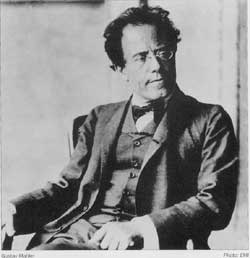Mahler's Unfinished Tenth by Catrina Flint de Médicis
/ March 2, 2003
Version française...
 In the summer of 1910, Alma Mahler dealt her
husband, Gustav Mahler, a blow so severe as to almost dwarf the anguish of his
own terminal illness--she had betrayed him in an affair with the architect
Walter Gropius. This pivotal event left an indelible mark on the final three
movements of the composer's tenth symphony, which he had begun weeks earlier,
setting the work as a whole irrevocably apart from the style of his earlier
symphonies. It was a composition he left incomplete upon his death less than a
year later, a fairly extensive draft which he nonetheless had asked be destroyed
in the event of his demise. But here again Alma betrayed him, though with the
apparent blessing of his contemporary colleagues Arnold Schoenberg, Alban Berg,
and Ernst Krenek, allowing a facsimile of the unfinished manuscript to be
published in 1924. Despite the harsh criticism of Theodore Adorno, Bruno Walter,
and Erwin Ratz, who vehemently opposed its completion by another hand, a wide
range of working or "performing editions" of Mahler's final symphony were
eventually produced for public consumption. And consume the public has with even
greater enthusiasm over the past thirty years, as a wide variety of performances
and recordings attest. In the summer of 1910, Alma Mahler dealt her
husband, Gustav Mahler, a blow so severe as to almost dwarf the anguish of his
own terminal illness--she had betrayed him in an affair with the architect
Walter Gropius. This pivotal event left an indelible mark on the final three
movements of the composer's tenth symphony, which he had begun weeks earlier,
setting the work as a whole irrevocably apart from the style of his earlier
symphonies. It was a composition he left incomplete upon his death less than a
year later, a fairly extensive draft which he nonetheless had asked be destroyed
in the event of his demise. But here again Alma betrayed him, though with the
apparent blessing of his contemporary colleagues Arnold Schoenberg, Alban Berg,
and Ernst Krenek, allowing a facsimile of the unfinished manuscript to be
published in 1924. Despite the harsh criticism of Theodore Adorno, Bruno Walter,
and Erwin Ratz, who vehemently opposed its completion by another hand, a wide
range of working or "performing editions" of Mahler's final symphony were
eventually produced for public consumption. And consume the public has with even
greater enthusiasm over the past thirty years, as a wide variety of performances
and recordings attest.
Mahler's tenth symphony poses a special set of problems for any musician,
scholar, or conductor brave enough to attempt an edition. It was composed during
a time of generalized artistic crisis in Germany: the unapologetic destruction
of tonal composition by composers such as Arnold Schoenberg butted up against
the reversion to classical styles most obvious in Richard Strauss's Der
Rosenkavalier, completed in the same year as Mahler's last symphony. Mahler
was not impervious to the changes going on around him. His own style was also
evolving, adding an extra layer of difficulty to the working out of his
unfinished score. The first of these "performing editions" or "works in
progress" as they are often called, takes the most liberty with Mahler's draft.
It was undertaken by Clinton Carpenter in 1946 but finished only in 1966, with a
first performance much later in 1983. Joe Wheeler's edition, begun in 1953 and
evolving through four versions, sits at the opposite end of the stylistic
spectrum, specifically allowing the composer's textures to be thinner at times,
perhaps as they might actually have evolved given the modernist climate and the
precedent of Das Lied von der Erde.
The standard version, and the one that will be broadcast on March 5 on
Radio-Canada's Chaîne culturelle, was realized by Deryck Cooke with the help of
Berthold Goldschmidt over the course of three decades, in three versions, all of
which have been aired and recorded. Cooke was an extremely sensitive
musicologist, with an unparalleled knowledge of Mahler's symphonic oeuvre that
came to his aid in places where it was necessary to supply counterpoint and
orchestration. Nonetheless, some of his decisions have been questioned: his
wholesale repetition of the "A" section at the end of the fourth movement
(Mahler had indicated a da capo,
but likely would have varied the repetition, as Cooke acknowledges); the use of
the military as opposed to the bass drum; and scoring the Purgatorio motifs that
reappear in the final movement for low brass instead of low strings. But these
seem to be fairly minor objections to Cooke's "performing edition"--a term he
coined in the firm belief that Mahler would have revised the work in the process
of fully orchestrating it, a task the composer set aside in favour of making
revisions to the ninth symphony in the winter of 1910-11. More recently Remo
Mazzetti has taken up the challenge with an edition that boasts thickened
orchestration, some new counterpoint, and a varied repetition of the
recapitulation in the fourth movement. But a performance tradition for
Mazzetti's version has yet to be set.
In the end the question of "finishing" the symphony is somewhat complex. Each
listener has different expectations of the Tenth: some want to hear more
of the eighth, others are interested in what the work might have sounded like if
Mahler had lived to hear Webern's Five Pieces for Orchestra (1911-13). But that really is the beauty of the ongoing project.
As each music editor and each conductor gives their opinion in sonic form, the
work evolves, changes and hopefully satisfies most of our desires. 
There is something of the "old" Mahler in this work, for instance, an
ironically set ländler in the first scherzo, an exquisitely paced and lengthy
lead-in to a foiled climax at the beginning of the finale which is brutally
snuffed out by a thudding drum beat, and an ending for the first movement that
simply evaporates in a pianissimo so quiet one honestly has to wonder if the
sound is real or imagined. There are cyclic elements, for instance the motifs
from the Purgatorio that recur in the finale, as well as fragments from the
first and fourth movements and quotations from Wagner's operas. These last
include the prelude to the third act of Parsifal and the shepherd's tune
from Tristan.
From a formal standpoint there
are some new things at work. The first movement has a sonata-like form with
three themes (the third is actually a variation of the first), in which the
exposition is repeated in varied form, as is the recapitulation. An extremely
long coda brings the work to an end and also provides the climax. The scherzos
are fairly tense, especially the second--no surprise given the subtitle "Der
Teufel tanzt es mit mir" (The devil dances with me)--where the trio never seems
to return in its original form, creating a great deal of unrest. In the first
scherzo, a number of metrical shifts severely break up the musical flow and
communicate a high degree of agitation. The finale is nerve-wracking, as
sporadic beats from the menacing drum force listeners to relinquish any and all
expectations. This device gives a jolt even if not performed loudly.
But there are moments of sheer
magnificence, painful beauty, and aching lyricism in this movement that make the
upsets all the more worthwhile. I would not give up that beautiful slow
unfolding of the Purgatorio theme as it rises out of the depths of the orchestra
at the beginning of the movement, nor the celestial flute solo that calms both
the ears and the soul. Some commentators have likened this movement to the
adagietto from the fifth symphony, though I believe they do so in error. This is
a unique movement, unique to Mahler and to the time during which it was written,
and most certainly it will be unique to whatever performance it receives, for
such is the nature of any work in progress.
Version française... |
|


